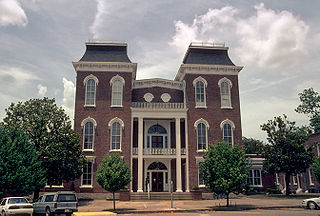
Mobile is a city and the county seat of Mobile County, Alabama, United States. The population within the city limits was 187,041 at the 2020 census, down from 195,111 at the 2010 census. After a successful vote to annex areas west of the city limits in July 2023, Mobile's population increased to 204,689 residents. It is now the second-most-populous city in Alabama, after Huntsville.

The history of what is now Alabama stems back thousands of years ago when it was inhabited by indigenous peoples. The Woodland period spanned from around 1000 BCE to 1000 CE and was marked by the development of the Eastern Agricultural Complex. This was followed by the Mississippian culture of Native Americans, which lasted to around the 1600 CE. The first Europeans to make contact with Alabama were the Spanish, with the first permanent European settlement being Mobile, established by the French in 1702.

Bullock County is a county of the U.S. state of Alabama. As of the 2020 census, the population was 10,357. Union Springs was chosen as the county seat in 1867, and presently is the county's only incorporated city. The county was named for Confederate Army Colonel Edward C. Bullock who was a state senator and outspoken secessionist who died during the American Civil War.

Choctaw County is a county located in the southwestern portion of the U.S. state of Alabama. As of the 2020 census, the population was 12,665. The county seat is Butler. The county was established on December 29, 1847, and named for the Choctaw tribe of Native Americans.

Stewart County is a county located on the northwestern corner of Middle Tennessee, in the U.S. state of Tennessee. As of the 2020 census, the population was 13,657. Its county seat is Dover. Stewart County is part of the Clarksville Metropolitan Statistical Area.

Eufaula is the largest city in Barbour County, Alabama, United States. As of the 2010 census the city's population was 13,137.

Union Springs is a city in and county seat of Bullock County, Alabama, United States. The population was 3,980 at the 2010 census.

Maplesville is a town in Chilton County, Alabama, United States. At the 2020 census, the population was 637. It is located approximately halfway between Tuscaloosa and Montgomery on U.S. Route 82.

Thomasville is a city in Clarke County, Alabama, United States. At the 2020 census, the population was 3,649. Founded as a late 19th-century railroad town, it has transitioned over the course of more than a century into a 21st-century commercial hub. It is the childhood hometown of author and storyteller Kathryn Tucker Windham.

Opelika is a city in and the county seat of Lee County in the east-central part of the U.S. state of Alabama. It is a principal city of the Auburn-Opelika Metropolitan Area. As of the 2020 census, the population of Opelika is 30,995, an increase of 17.1 percent from the 2010 Census where the population was 26,477. The Auburn-Opelika, AL MSA with a population of 150,933, along with the Columbus, Georgia metropolitan area, comprises the Greater Columbus combined statistical area, a region home to 501,649 residents.

Huntsville is the most populous city in the U.S. state of Alabama. It is the county seat of Madison County with portions extending into Limestone County and Morgan County. It is located in the Appalachian region of northern Alabama.

United States Steel Corporation, more commonly known as U.S. Steel, is an American integrated steel producer headquartered in Pittsburgh, Pennsylvania, with production operations primarily in the United States of America and in Central Europe. The company produces and sells steel products, including flat-rolled and tubular products for customers in industries across automotive, construction, consumer, electrical, industrial equipment, distribution, and energy. Operations also include iron ore and coke production facilities.

The Atlanta and St. Andrews Bay Railroad, also known as the Bay Line, was a Class I railroad which operated in Alabama and Florida. The company was founded in 1906 and opened its mainline between Dothan, Alabama, and Panama City, Florida, in 1908. Later reclassified as a short-line railroad, its assets were acquired by the Bay Line Railroad in 1994.

The Alabama & Gulf Coast Railway is a Class II railroad owned by Genesee & Wyoming. It operates 339 miles (546 km) of track from the Pensacola, Florida export terminals, west of downtown, north to Columbus, Mississippi, with trackage rights along BNSF Railway to Amory, Mississippi. A branch uses trackage rights along Norfolk Southern from Kimbrough, Alabama west and south to Mobile, Alabama, with separate trackage at the end of the line in Mobile.

Minnesela is a ghost town and was the first settlement in and county seat of Butte County, South Dakota, United States. Minnesela was founded in 1882 and was located three miles southeast of present-day Belle Fourche. The railroad's decision to bypass Minnesela and to continue on to Belle Fourche in 1890 caused the town to be abandoned by 1901.

Seale is an unincorporated community in Russell County, Alabama, United States. It was the county seat from 1868 until 1935, and is currently home to Russell County High School and middle school. The former Russell County courthouse, built in 1868, is located in the town.
The Pine Belt Southern Railroad was a shortline railroad formerly operating on two disconnected track segments in east central Alabama. Upon its start in 1995 the railroad ran over a branch from Nuckols to Hurtsboro, Alabama. In 1996 a second branch was acquired, extending from Roanoke, Jct., near Opelika, to Lafayette, Alabama. Together the lines totaled 42.4 miles (68.2 km) and the railroad was controlled by Richard Abernathy.

The Mobile & Girard Railroad was an Alabama railroad which was constructed in the mid-19th century; a portion of the line continues in operation under different ownership. The 26-mile (42 km) line was constructed with a track gauge of 5 ft.
The Andalusia and Conecuh Railroad was a shortline railroad formerly operating between Gantt and Andalusia, Alabama, United States 8.7 miles (14.0 km). It was largely abandoned in 1987, with the remainder leased to the Alabama and Florida Railway. A portion of the railroad survives today as part of the Three Notch Railroad.

Columbus and Chattahoochee Railroad is a 26-mile-long (42 km) freight railroad running from Girard, Alabama, to Mahrt, Alabama, and has shared trackage rights with the Norfolk Southern to use the track between NS Columbus yard in Columbus, Georgia, and Girard, Alabama. This track runs concurrent with 9th St. in downtown Columbus and is shared as part of the designated yard limits for Columbus Yard. CHH interchanges with the Norfolk Southern at Columbus Yard. Locomotives are kept at the yard and crew office for Georgia Southwestern Railroad yard in Columbus.



















